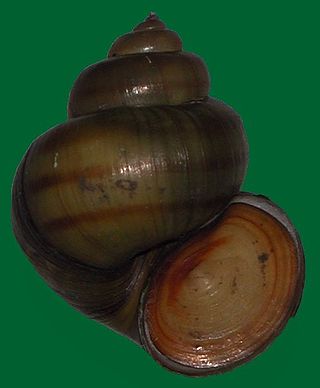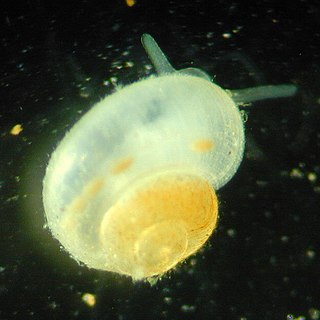
Littorinimorpha is a large order of snails, gastropods, consisting primarily of sea snails, but also including some freshwater snails and land snails.

Oncomelania hupensis is a species of very small tropical freshwater snail, an aquatic gastropod mollusk in the family Pomatiopsidae.

Viviparidae, sometimes known as the river snails or mystery snails, are a family of large operculate freshwater snails, aquatic gastropod mollusks.
Tricula is a genus of freshwater snails with a gill and an operculum, aquatic gastropod mollusks in the family Pomatiopsidae.

Amnicolidae is a family of small freshwater snails with a gill and an operculum, aquatic gastropod mollusks in the superfamily Rissooidea.

Cochliopidae is a family of small freshwater snails with gills and an operculum, aquatic gastropod mollusks.

Freshwater snails are gastropod mollusks that live in fresh water. There are many different families. They are found throughout the world in various habitats, ranging from ephemeral pools to the largest lakes, and from small seeps and springs to major rivers. The great majority of freshwater gastropods have a shell, with very few exceptions. Some groups of snails that live in freshwater respire using gills, whereas other groups need to reach the surface to breathe air. In addition, some are amphibious and have both gills and a lung. Most feed on algae, but many are detritivores and some are filter feeders.
Tomichia is a genus of very small freshwater snails which have a gill and an operculum, gastropod mollusks or micromollusks in the family Tomichiidae.

Cecina is a genus of sea snails which have a gill and an operculum, gastropod mollusks or micromollusks in the family Pomatiopsidae.

Blanfordia is a genus of terrestrial gastropod mollusks in the family Pomatiopsidae. They are land snails which have an operculum.
Coxiella is a genus of aquatic gastropod mollusks in the family Tomichiidae. These snails that live in saline lakes, and have gills and an operculum.
Erhaia is a genus of small to minute freshwater snails with a gill and an operculum, aquatic gastropod mollusks in the family Amnicolidae.

Neotricula is a genus freshwater snails which have a gill and an operculum, gastropod mollusks or micromollusks in the family Pomatiopsidae.
Robertsiella is a genus of freshwater snails which have a gill and an operculum, gastropod mollusks or micromollusks in the family Pomatiopsidae.
Gammatricula is a genus of freshwater snails which have a gill and an operculum, gastropod mollusks or micromollusks in the family Pomatiopsidae.
Kunmingia is a genus of freshwater snails with gills and an operculum, aquatic gastropod mollusks in the family Pomatiopsidae.
†Paraprosostenia is a fossil genus of prehistoric freshwater snails, aquatic gastropod mollusks in the family Pomatiopsidae.
Neoprososthenia is a genus of freshwater snails with gills and an operculum, aquatic gastropod mollusks in the family Pomatiopsidae.
Hubendickia is a genus of freshwater snails with gills and an operculum, aquatic gastropod mollusks in the family Pomatiopsidae.

Truncatelloidea is a superfamily of snails, gastropod mollusks in the clade Caenogastropoda.











